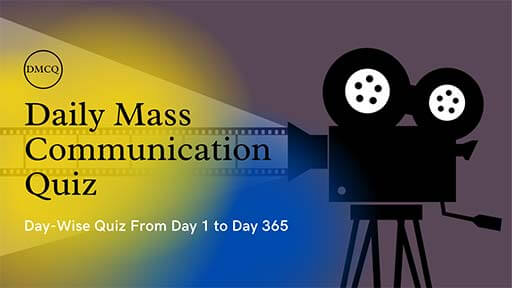Journalism and Mass Communication Objective Questions (DMCQ)
1.How many of the sensory channels can be applied while viewing a television programme?
a. One
b. Two
c. Three
d. Four
Correct Answer: (B) Two
Explanation: Marshall McLuhan contended that media operate by their extension of the human senses. For example, reading a book ostensibly needs only the sense of vision similarly viewing a television programme needs two sensory channels hearing and vision.
2. Who among the following is a gatekeeper?
a. Reader
b. Viewer
c. Listener
d. Editor
Correct Answer: (D) Editor
Explanation: The theory that relates most to the concept of editors making decisions to remove content is gatekeeping theory. Gatekeeping is the process of publication and the way information from a news event passes through a number of gates and gets changed by the process.
3. Who coined the term kinesics?
a Robert Frost
b. Wilbur Schramm
c. Daniel Lerner
d. Ray Birdwhistell
Correct Answer: (D) Ray Birdwhistell
Explanation: Kinesics, a term coined by American anthropologist Ray Birdwhistell, is the study nonverbal communication. Kinesics is the interpretation of body motion communication such as facial expressions and gestures, nonverbal behavior related to movement of any part of the body or the body as a whole.
4. Communicating within oneself is known as….
a. Group Communication
b. Transpersonal Communication
c. Intrapersonal communication
d. Interpersonal communication
Correct Answer: (C) Intrapersonal communication
Explanation: Intrapersonal communication can be defined as communication with one’s self, and that may include self-talk, acts of imagination and visualization, and even recall and memory.
5. Howling and hooting by the audience during a public speech is an example of….
a. Positive feedback
b. Neutral feedback
c. Complementary feedback
d. Negative feedback
Correct Answer: (D) Negative feedback
Explanation: Negative feedback occurs when some function of the output of a system, process, or mechanism is fed back in a manner that tends to reduce the fluctuations in the output, whether caused by changes in the input or by other disturbances.
6. Who among the following considered communication as a sharing process?
a. Dhama and Bhatnagar
b. Wilbur Schramm
c. Joseph A Devito
d. Ban and Hawkins
Correct Answer: (B) Wilbur Schramm
Explanation: The Schramm model views communication as a process that takes place between a sender (transmitter) and a receiver: there will be also a message, and a medium through which the message can be transmitted.
7. The act of producing a message is known as….
a) Decoding
b) Messaging
c) Noise
d) Encoding
Correct Answer: (D) Encoding
Explanation: The encoding of a message is the production of the message. It is a system of coded meanings, and in order to create that, the sender needs to understand how the world is comprehensible to the members of the audience.
The decoding of a message is how an audience member is able to understand, and interpret the message.
8. Retranslating a message to extract meaning is known as…..
a. Decoding
b. Messaging
c. Encoding
d. Noise
Correct Answer: (A) Decoding
Explanation: When you decode a message, you extract the meaning of that message in ways that make sense to you.
The decoding of a message is how an audience member is able to understand, and interpret the message.
9. What is proxemics?
- Study of space in communication
- Study of eye behavior
- Study of touching
- Study of body movements
Correct Answer: (A) Study of space in communication
Explanation: Proxemics is the study of human use of space and the effects that population density has on behaviour, communication, and social interaction.
10. Anything that interferes with a message in communication is known as………
- Context
- Noise
- Decoding
- Feedback
Correct Answer: (B) Noise
Explanation: Noise, in communication terms, means any interference that makes it harder for the stakeholder to firstly receive, then interpret the message, and its meaning.




















